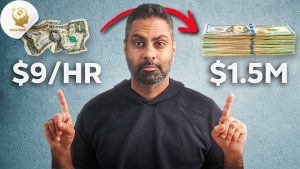
Beginner
Task 1: Share Your Opinion 🗣️
After watching the video, tell your partner or a small group your opinion on one of the following topics. Use simple sentences.
- Do you think money can buy happiness? Why or why not?
- Do you feel happy for your friends when they get something new and nice?
- What is one thing you would buy if you had $500,000 a year?
Task 2: Describe a Scene 🎬
Imagine you are one of the characters in the video. Describe your feelings.
- You are the person with the $2 million bonus. Describe how you feel after learning your colleague got $2 million and one.
- You are Bill, the doctor. Describe how you felt before and after meeting your neighbor Stan.
Task 3: Role-Play a Simple Conversation 🎭
With a partner, role-play a short conversation. One person has something new and the other is a little jealous. The conversation should end with the jealous person accepting that what they have is enough.
Intermediate
Task 1: Summarize the “Never Enough” Idea 📝
In a small group, discuss and explain the main idea of the video. Use the examples of Bill, Stan, and Michael Jordan to illustrate how social comparison can lead to the feeling of “never enough.”
Task 2: Discuss the Dangers of Envy 🛑
The video mentions that envy can lead people to do foolish things. In your group, discuss the different foolish actions mentioned in the video.
- What are some of the things people have done?
- Why do you think they did this?
- What is the lesson from this part of the video?
Task 3: Compare and Contrast 🔄
The video states that capitalism generates two things: wealth and envy. Discuss this statement with a partner.
- How does capitalism generate wealth?
- How does it generate envy?
- Do you think the “urge to surpass” others is a good thing or a bad thing?
Advanced
Task 1: Analyze the “Pyramid” Analogy 🔺
The video describes a pyramid of wealth, from Bill to Jeff Bezos. In a group, discuss this analogy.
- How does the pyramid structure illustrate the concept of social comparison?
- What is the significance of the statement, “There’s always a bigger fish”?
- How does this model relate to the “hedonic treadmill” in psychology (the idea that we quickly return to a baseline level of happiness despite major positive or negative events)?
Task 2: Debate a Statement ⚖️
The video suggests that we should “at some point accept that enough is enough.” Debate this statement in a small group.
- One side argues that this is an important part of personal well-being and financial freedom.
- The other side argues that it’s okay to want more and that this desire can be a healthy motivator for success.
Task 3: Deliver a “Mini-Lecture” 🧑🏫
Prepare a short, informative talk (2-3 minutes) for your classmates. Choose one of the key takeaways from the video and present it.
- Option A: Explain the paradox of “never enough” using the example of the $2 million bonus.
- Option B: Explain the dangers of envy, using the example of people who did foolish things with their money.
- Option C: Explain the final piece of advice: “Never risk what you have and need for what you don’t have and don’t need,” and provide a personal example
Beginner
Task 1: Listen for Key Information 👂 Listen to the video and write down the answers to these questions with a short phrase or a single word.
- What is the example given of something that can make a person with a $2 million bonus sick?
- What is the name of the doctor mentioned in the video?
- What is the name of Stan’s famous childhood friend?
- How much money did Stan get paid per year?
Task 2: Identify Who’s Who 🤔 Listen to the video and identify the role of each person.
- Bill: a highly specialized doctor
- Stan: __________________
- Jeff Bezos: __________________
- Michael Jordan: __________________
Task 3: Complete the Sentence 📝 Listen to the video and complete the sentences with the missing words.
- Capitalism is great at doing two things: generating wealth and generating __________________.
- Bill bought a vacation home in the __________________.
- Compared to Michael’s fortune, Stan’s yearly salary seems like __________________.
- There’s always a bigger __________________.
Intermediate
Task 1: Listen for Main Ideas 📖 Listen to the video and summarize the main idea of the following sections.
- Section 1 (0:00 – 0:50): The video’s main point about a $2 million bonus and how capitalism works.
- Section 2 (0:50 – 2:00): The story of the doctor (Bill), his neighbor (Stan), and their friends.
- Section 3 (2:00 – end): The consequences of envy and the final lesson about being satisfied.
Task 2: Listen for Specific Details 🔍 Listen to the video and answer the questions with complete sentences.
- What is the income required to be in the top 1% of highest income earners in the US?
- What does the video say is a good thing about the urge to surpass others?
- What are some of the “foolish things” people have done because of envy?
- What is the final piece of advice given in the video?
Task 3: Paraphrase the Quote 🗣️ Listen to the video and explain the following quotes in your own words.
- “Social comparison can also cause us to feel like we’re never enough.”
- “Stan’s yearly salary of $10 million suddenly seems like peanuts.”
- “We will not trade something that we have and need for something that we don’t have and don’t need.”
Advanced
Task 1: Listen for Implicit Meaning 🧠 Listen to the video and explain the deeper meaning behind these statements, based on the context.
- “They’re sick for the next year.”
- “There’s always a bigger fish.”
- “The average Joe can only dream about.”
Task 2: Note-Taking and Analysis ✍️ Listen to the video and take notes on the main concepts presented. Afterward, write a brief analysis of how the speaker uses a narrative structure and hierarchy of wealth to make the complex idea of social comparison and envy understandable. What makes this progression of examples effective?
Task 3: Analyze the Language 🗣️ Listen to the video and focus on the vocabulary and phrases used.
- Explain what the phrase “leverage their portfolios to the teeth” means in the context of the video.
- What is the speaker’s tone throughout the video? Is he angry, disappointed, or something else?
- The speaker uses the name “Average Joe.” What does this phrase mean in this context? What does it imply about the listener?
Beginner
Task 1: Matching
Read the sentences about the video and match the first part of the sentence to the correct second part.
- A $2 million bonus is not enough if someone
- Capitalism creates wealth and
- Bill the doctor earns
- Stan is a
- There is always
Sentences: a. earns $2 million and one. b. a bigger fish. c. envy. d. CEO. e. $500,000 a year.
Task 2: True or False
Read the following sentences. Write “T” if the sentence is true or “F” if it is false, based on the video.
- The video says that wanting to be better than your friends is a bad thing.
- Bill felt good about his money until he met his neighbor.
- Stan is richer than Michael Jordan.
- People have made foolish decisions because of envy.
- It’s a good idea to risk money you need for something you want.
Task 3: Vocabulary and Definitions
Read the following words from the video and match them to their simple definitions.
- envy:
- tedious:
- staggering:
- fortune:
- reputation:
Definitions: a. a very large amount of money. b. feeling that you want what someone else has. c. boring and slow. d. a person’s good name. e. very surprising or shocking.
Intermediate
Task 1: Read for Specific Details
Read the video and answer the following questions with details from the text.
- What are the two things the video says capitalism is great at doing?
- What is the income required to be in the top 1% of highest income earners?
- What are some of the ways Bill, the doctor, can spend his money?
- What are three negative consequences of envy mentioned in the video?
Task 2: Find the Quotes
Read the video carefully and find the quotes that match the descriptions below.
- The quote that describes how an extra dollar can make someone with $2 million feel.
- The quote that describes Stan’s salary in comparison to Michael Jordan’s fortune.
- The quote that explains what people should not trade.
- The quote that describes the result of social comparison.
Task 3: Summarize a Paragraph
Choose one of the following key ideas from the video and write a short paragraph (4-5 sentences) summarizing it. Explain the idea and use one of the examples from the video to support your summary.
- The “never enough” phenomenon.
- The pyramid of wealth.
- The foolish things people do because of envy.
Advanced
Task 1: Analyze Text Structure
Read the video and analyze its structure. Answer the following questions.
- How does the opening sentence about the $2 million bonus serve as a hook to introduce the central theme of the video?
- How does the speaker use the series of names (Bill, Stan, Michael Jordan, Jeff Bezos) to create a sense of scale and illustrate the idea that “There’s always a bigger fish”?
- What is the purpose of the final paragraph? How does it connect the detailed examples to a general, personal lesson for the viewer?
Task 2: Critical Reading and Interpretation
Read the video and write a short response to the following questions.
- The video states that the “urge to surpass” others can be a good thing. Explain how this positive side of social comparison is balanced against the negative side of envy.
- The video says that Stan’s $10 million salary “suddenly seems like peanuts” compared to Michael Jordan’s fortune. What is the psychological reason for this feeling?
- Do you agree with the video’s final piece of advice: “We will not trade something that we have and need for something that we don’t have and don’t need”? Use evidence from the text and your own ideas to support your answer.
Task 3: Vocabulary in Context
Read the video and explain the meaning of the following words as they are used in the text.
- surpass (Paragraph 1)
- peanuts (Paragraph 3)
- leveraged (Paragraph 4)
- forsaken (Paragraph 4)
- financial freedom (Paragraph 5)
Beginner
Task 1: Fill in the Blanks
Read the following sentences about the video and fill in the blanks using words from the video.
- The video says that __________________ is a very interesting phenomenon.
- Bill earns about __________________ a year.
- Stan earns a staggering __________________ per year.
- Stan’s childhood friend is the basketball player __________________.
- The richest man, Jeff Bezos, has about __________________ in his net worth.
Task 2: Write a Short Summary
Write a short paragraph (3-4 sentences) summarizing the main idea of the video. Explain why it says “never enough.”
Task 3: Write a Short Story
Imagine you have a friend who is jealous of another person’s new bicycle. Write a short story about your friend’s feelings, and how you could use the ideas from the video to help them feel better.
Intermediate
Task 1: Write a Persuasive Note
Write a note to a friend who is always comparing themselves to others on social media. Use the ideas from the video to persuade them to stop this behavior. Explain how comparing yourself to others can make you feel like you are “never enough.”
Task 2: Write a Journal Entry
Imagine you are “Bill,” the highly specialized doctor. Write a journal entry about your day. Explain how you felt about your financial achievements until you met your neighbor Stan, and how that changed your perspective.
Task 3: Write a Short Blog Post
Write a short blog post titled, “The Trap of Envy.” Use the examples of Bill, Stan, and Michael Jordan to explain how social comparison can lead to unhappiness and foolish financial decisions.
Advanced
Task 1: Write an Essay
Write a short essay (2-3 paragraphs) analyzing the statement, “Capitalism is great at doing two things: generating wealth and generating envy.” Discuss how the video illustrates this idea through the examples of Bill, Stan, Michael Jordan, and Jeff Bezos.
Task 2: Write a Business Report
Imagine you are a human resources consultant. Write a report for a company about how to manage employee morale and prevent envy in the workplace. Use the story of the doctor and his neighbor to explain why it is important to focus on individual achievements rather than social comparison.
Task 3: Analyze and Respond
The video discusses how some people “have leveraged their portfolios to the teeth in order to move up to a higher pyramid just to lose it all and then commit suicide.” Write an analysis of this statement. What does it reveal about the psychological dangers of envy and social comparison? How does it connect to the video’s final piece of advice: “never risk what you have and need for what you don’t have and don’t need”?





